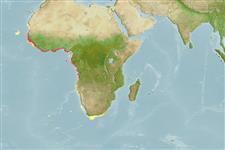Paragaleus pectoralis (Garman, 1906)
Atlantic weasel shark
Add your observation in Fish Watcher
| Native range | All suitable habitat | Point map | Year 2050 |

|
| This map was computer-generated and has not yet been reviewed. |
| Paragaleus pectoralis AquaMaps Data sources: GBIF OBIS |
Upload your photos and videos
Pictures | Google imageParagaleus pectoralis
Picture by FAO
Pictures | Google imageParagaleus pectoralis
Picture by FAO
Classification / Names Nombres comunes | Sinónimos | Catalog of Fishes(Género, Especie) | ITIS | CoL | WoRMS | Cloffa
Elasmobranquios (tiburones y rayas) (sharks and rays) > Carcharhiniformes (Ground sharks) > Hemigaleidae (Weasel sharks)
Etymology: Paragaleus: para (Gr.), near, referring to how its dentition is intermediate between Hemigaleus and the triakid Eugaleus (=Galeorhinus) (See ETYFish); pectoralis: Latin for pectoral, allusion not explained, possibly referring to its characteristic falciform pectoral fins (See ETYFish).
More on author: Garman.
Etymology: Paragaleus: para (Gr.), near, referring to how its dentition is intermediate between Hemigaleus and the triakid Eugaleus (=Galeorhinus) (See ETYFish); pectoralis: Latin for pectoral, allusion not explained, possibly referring to its characteristic falciform pectoral fins (See ETYFish).
More on author: Garman.
Environment: milieu / climate zone / depth range / distribution range Ecología
marino demersal; rango de profundidad ? - 100 m (Ref. 5578), usually 30 - 70 m (Ref. 10730). Tropical; 30°N -
Distribución Países | Áreas FAO | Ecosistemas | Ocurrencias, apariciones | Point map | Introducciones | Faunafri
Eastern Atlantic: Cape Verde and Mauritania to northern Namibia (Ref. 244, 5578); possibly extending north to Morocco. Record from the Northwest Atlantic, specifically in New England, has not been verified even after an extensive survey of the area has been conducted.
Length at first maturity / Tamaño / Peso / Age
Maturity: Lm 82.5, range 75 - 90 cm
Max length : 140 cm TL macho / no sexado; (Ref. 5578); common length : 100.0 cm TL macho / no sexado; (Ref. 26999)
Max length : 140 cm TL macho / no sexado; (Ref. 5578); common length : 100.0 cm TL macho / no sexado; (Ref. 26999)
Short description Claves de identificación | Morfología | Morfometría
Espinas dorsales (total) : 0; Espinas anales: 0. A slender weasel shark with a moderately long snout, large eyes, and a short, small mouth with small, serrated upper teeth and erect-cusped lower teeth (Ref. 5578). Light grey or bronze with longitudinal yellow stripes, fins plain; white below (Ref. 5578).
A very common inshore to offshore shark of the continental shelf occurring at depths of a few meters to slightly over 100 m (Ref. 244). A specialist feeder that prefers cephalopods, also feeds on small bony fishes (Ref. 244). Viviparous (Ref. 50449). Utilized fresh and dried salted for human consumption, and processed into fishmeal (Ref. 244).
Life cycle and mating behavior Madurez | Reproducción | Puesta | Huevos | Fecundidad | Larva
Viviparous (with a yolk-sac placenta), with 1 to 4 young per litter. Size at birth about 47 cm (Ref. 244). Distinct pairing with embrace (Ref. 205).
Main reference
Upload your references | Referencias | Coordinador | Colaboradores
Compagno, L.J.V., 1984. FAO Species Catalogue. Vol. 4. Sharks of the world. An annotated and illustrated catalogue of shark species known to date. Part 2 - Carcharhiniformes. FAO Fish. Synop. 125(4/2):251-655. Rome: FAO. (Ref. 244)
IUCN Red List Status (Ref. 130435: Version 2024-2)
Endangered (EN) (A2bd); Date assessed: 04 August 2020
CITES
Not Evaluated
Threat to humans
Harmless
Human uses
Pesquerías: comercial
FAO - Publication: search | FishSource |
Más información
Trophic ecology
componentes alimenticios
Composición de la dieta
consumo de alimento
Food rations
Despredadores
componentes alimenticios
Composición de la dieta
consumo de alimento
Food rations
Despredadores
Population dynamics
Coeficiente del crecimiento para
Max. ages / sizes
Length-weight rel.
Length-length rel.
Length-frequencies
Mass conversion
Reclutamiento
Abundancia
Coeficiente del crecimiento para
Max. ages / sizes
Length-weight rel.
Length-length rel.
Length-frequencies
Mass conversion
Reclutamiento
Abundancia
Life cycle
Reproducción
Madurez
Maturity/Gills rel.
Fecundidad
Puesta
Spawning aggregations
Huevos
Egg development
Larva
Dinámica larvaria
Reproducción
Madurez
Maturity/Gills rel.
Fecundidad
Puesta
Spawning aggregations
Huevos
Egg development
Larva
Dinámica larvaria
Anatomy
Superficie branquial
Brain
Otolith
Superficie branquial
Brain
Otolith
Physiology
Body composition
Nutrients
Consumo del oxígeno
Tipo de natación
Velocidad de natación
Visual pigments
Fish sound
Diseases & Parasites
Toxicity (LC50s)
Body composition
Nutrients
Consumo del oxígeno
Tipo de natación
Velocidad de natación
Visual pigments
Fish sound
Diseases & Parasites
Toxicity (LC50s)
Genetics
Genética
Heterozygosity
heritabilidad
Genética
Heterozygosity
heritabilidad
Human related
Aquaculture systems
Perfiles de acuicultura
Razas
Ciguatera cases
Stamps, coins, misc.
Aquaculture systems
Perfiles de acuicultura
Razas
Ciguatera cases
Stamps, coins, misc.
Herramientas
E-book | Guía de campo | Asistente para frecuencias de tallas | Herramienta de ciclo de vida | Mapa de puntos | Classification Tree
| Catch-MSY |
Special reports
Download XML
Fuentes de Internet
AFORO (otoliths) | Aquatic Commons | BHL | Cloffa | BOLDSystems | Websites from users | Check FishWatcher | CISTI | Catalog of Fishes: Género, Especie | DiscoverLife | ECOTOX | FAO - Publication: search | Faunafri | Fishipedia | Fishtrace | GenBank: genome, nucleotide | GloBI | Google Books | Google Scholar | Google | IGFA World Record | MitoFish | Otolith Atlas of Taiwan Fishes | PubMed | Reef Life Survey | Socotra Atlas | Árbol de la vida | Wikipedia: Go, búsqueda | World Records Freshwater Fishing | Expediente Zoológico
Estimates based on models
Preferred temperature (Ref. 123201): 17.7 - 25.9, mean 19.9 °C (based on 45 cells).
Phylogenetic diversity index (Ref. 82804): PD50 = 0.5664 [Uniqueness, from 0.5 = low to 2.0 = high].
Bayesian length-weight: a=0.00355 (0.00144 - 0.00875), b=3.07 (2.85 - 3.29), in cm total length, based on LWR estimates for this (Sub)family-body shape (Ref. 93245).
Nivel trófico (Ref. 69278): 4.3 ±0.64 se; based on food items.
Resiliencia (Ref. 120179): Muy bajo, población duplicada en un tiempo mínimo superior a 14 años (Fec=1).
Fishing Vulnerability (Ref. 59153): Very high vulnerability (84 of 100).




